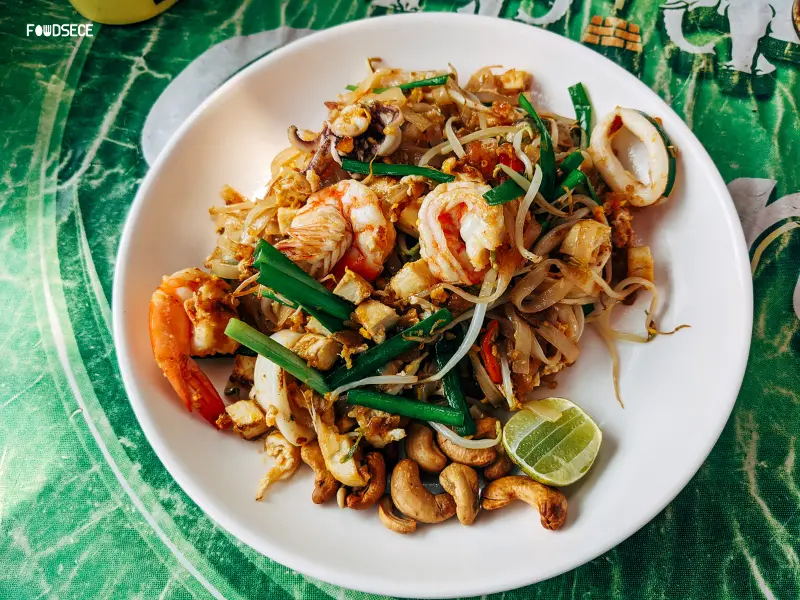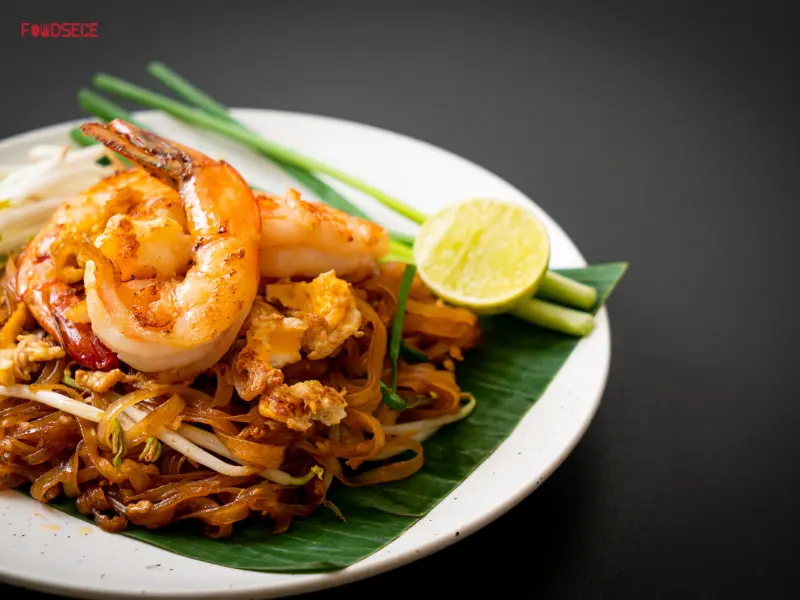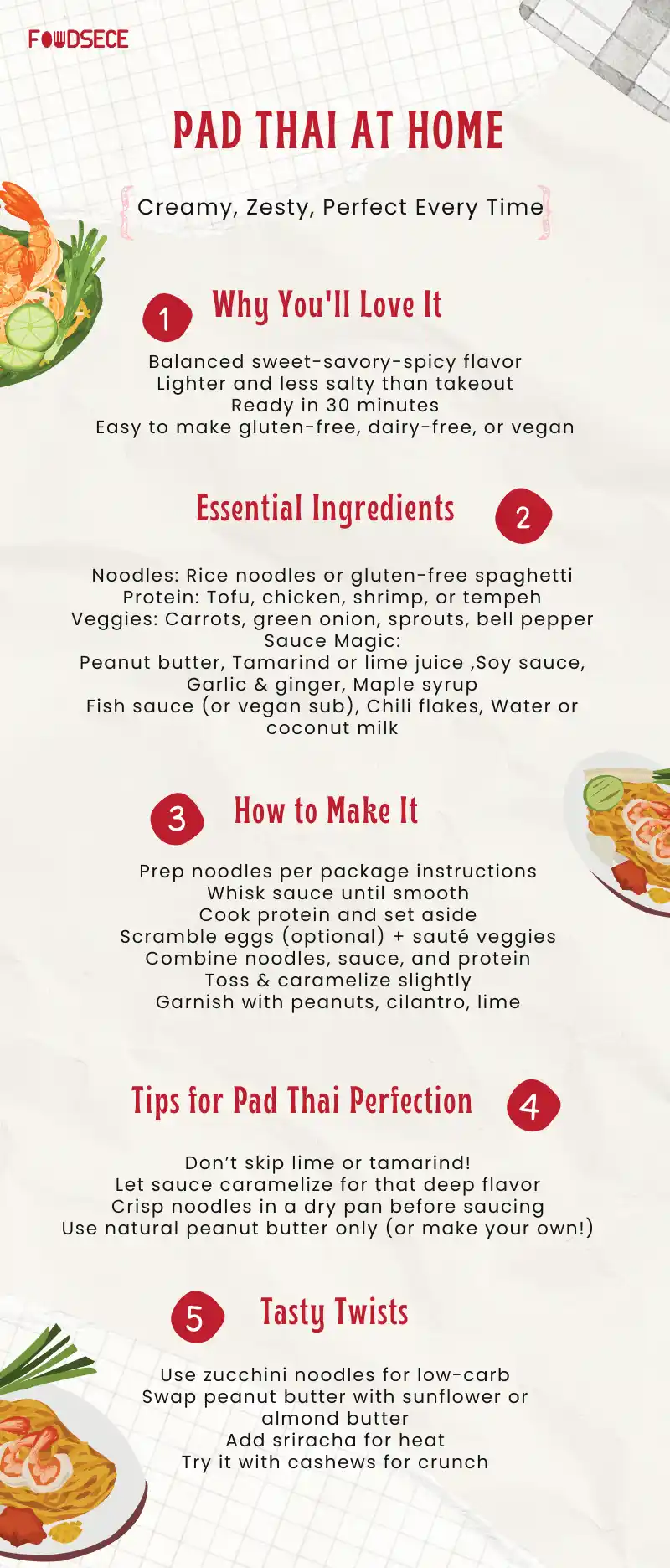Love how Pad Thai with peanut sauce tastes, but wish it had a little more zing and a little less salt? You’re not alone. This version of pad thai only uses peanut butter and plenty of Thai herbs to flavor it more naturally.
Because of this, I decided to try making my own version. I enjoyed the traditional version by Tiffany, but I wanted an update that would have more freshness, use Thai spice and have a better combination of flavors. Imagine flavors that are creamy, tangy, sweet and savory, while avoiding too much of any one flavor.
So the goal here is to preserve the signature creaminess of peanut butter, yet tone it down for a more enjoyable taste and simple texture. This recipe is perfect for if you want best Thai food from the comfort of home or a takeout meal.
Why You’ll Love This Pad Thai Recipe
Making this for a fast dinner is something I do all the time now! I believe you’ll come to love it just as much as I have:
- Balanced flavor: A mix of creamy, tangy, salty, and a tiny kick of heat.
- Health-conscious swaps: Less sodium, less oil, and more veggies.
- Quick and easy: Ready in just 30 minutes.
- Flexible: Make it gluten-free, vegetarian, or vegan with simple adjustments.

Visit: Keto Peanut Butter Cookies: Low-Carb, Chewy and Sugar-Free Recipe
Ingredients Overview
To keep things simple, I’ve grouped the ingredients into easy categories. You might already have most of these on hand!
A. Noodles & Base
- Rice noodles (I used medium-width, but you can also sub gluten-free spaghetti or even zoodles)
B. Protein Options
- Shrimp, chicken, tofu, or tempeh — whatever you like!
C. Veggies
- Carrots, green onions, bean sprouts, and bell peppers are my staples
- Optional add-ins: edamame, shredded cabbage, or bok choy for extra crunch and nutrition
D. Creamy Pad Thai Sauce Recipe (Balanced Version)
This is where the magic happens — the sauce! It’s what transforms simple ingredients into the wow you expect from your favorite Thai takeout. My version cuts down on the sweetness and sodium, but still delivers bold, umami-rich flavor.
- 2–3 tablespoons natural peanut butter (or try homemade — more on that below!)
- 1 tablespoon tamarind paste or juice of one lime
- 2 tablespoons reduced-sodium soy sauce or coconut aminos
- 1 tablespoon maple syrup or coconut sugar
- 1–2 teaspoons fresh minced garlic and grated ginger
- 1 tablespoon fish sauce (or sub with vegan “fish” sauce)
- ½ cup warm water or light coconut milk to thin
- Sriracha or chili flakes to taste
If you’re curious how to make peanut butter or want to try your own, check out my tips near the end of the post!
How to Make This Pad Thai Recipe
If this is your first time making homemade Pad Thai, don’t worry — it’s easier than it looks. Once everything’s prepped, it all comes together lightning-fast.

- Soak or cook noodles according to package directions. Drain and rinse with cold water.
- Mix your sauce: Whisk or blend everything until smooth. Set aside.
- Cook your protein in a little oil until done. Remove and set aside.
- In the same pan, scramble eggs if using. Then add your chopped veggies and sauté for 2–3 minutes until just tender.
- Add in the noodles and pad thai sauce. Toss to coat everything well.
- Return your cooked protein to the pan and stir everything together.
- Let the sauce caramelize slightly (this adds amazing depth).
- Garnish with crushed peanuts, fresh cilantro, lime wedges, and extra chili flakes.
Why This Version Works Better
Let’s be honest — traditional Pad Thai can sometimes feel a little heavy. This version keeps all the flavor, but dials things in so you can feel good eating it often.
- Lighter: Uses less oil and just enough peanut butter to get the creamy texture
- Balanced flavor: Not too sweet or too salty, thanks to lime, tamarind, and fish sauce
- Lower sodium: Reduced-sodium soy sauce and smaller portions make a big difference
- Flexible: Dairy-free, gluten-free, and can be made vegan with a few swaps
Plus, I’ve had friends ask for this thai peanut sauce recipejust to use on other dishes. It’s that good!
Discover: Healthy Okra Recipes – Easy Roasted & Boiled Cooking Tips
Tips & Tricks
Here are a few pro tips that’ll take your homemade Pad Thai from good to amazing:
- Don’t skip the lime juice or tamarind — this acidity balances the creamy richness
- Fresh garlic and ginger > powdered, every time
- Want a little crisp on your noodles? Sauté them dry in the pan for 1–2 minutes before adding sauce
- Letting the sauce caramelize in the pan is the secret to that “restaurant” flavor
Add-ins & Variations
This pad thai recipe is super forgiving and fun to customize. Here are a few ideas:
- Use slivered almonds or cashews if you have peanut allergies
- Sub the noodles with spiralized zucchini or kelp noodles for a low-carb version
- Try sunflower seed butter if you’re going for a nut-free peanut sauce recipe
- Add extra sriracha or Thai chili flakes if you like it spicy
Curious About the Healthiest Peanut Butter?
If you’re trying to lighten this up even more, look for natural peanut butter with just one ingredient: peanuts. Avoid anything with added sugars or oils. Or, try homemade peanut butter — just roast peanuts and blend until smooth!
Storage & Reheating
- Best served fresh, but it reheats like a dream!
- Store leftovers in an airtight container in the fridge for up to 4 days
- Reheat in a skillet with a splash of water or coconut milk to loosen the sauce
- Freezing? Not my favorite — the noodles go soft — but fine in a pinch

This mouth watering pad thai recipe is a must try!
So there you have it — a creamy, zesty, balanced pad thai recipe that you can feel great about making again and again. With just 30 minutes and one pan, you get all the joy of a takeout favorite with none of the post-meal regret.
Whether you’re exploring Thai flavors for the first time or just looking for a weeknight hero, this one’s a keeper. And if you give it a go, tag me or leave a comment — I’d love to hear how you made it your own.
Ready to try the best Thai food at home?

